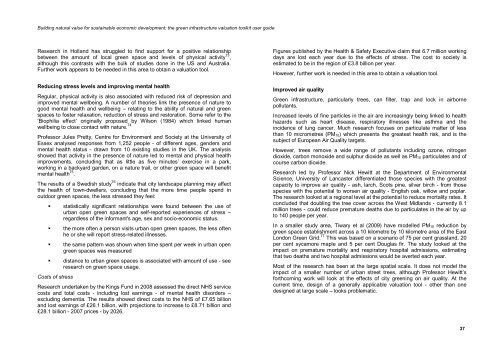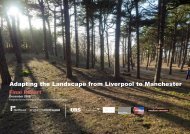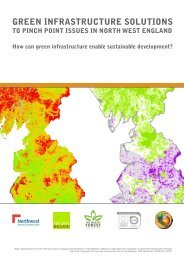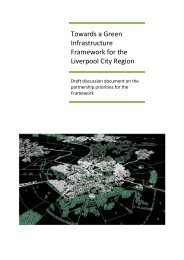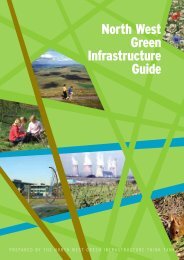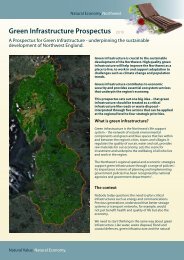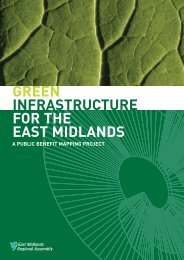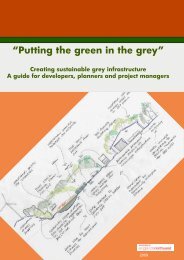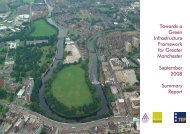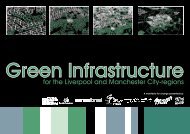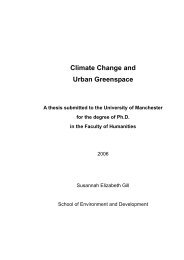The green infrastructure valuation toolkit user guide
The green infrastructure valuation toolkit user guide
The green infrastructure valuation toolkit user guide
Create successful ePaper yourself
Turn your PDF publications into a flip-book with our unique Google optimized e-Paper software.
Building natural value for sustainable economic development: the <strong>green</strong> <strong>infrastructure</strong> <strong>valuation</strong> <strong>toolkit</strong> <strong>user</strong> <strong>guide</strong><br />
Research in Holland has struggled to find support for a positive relationship<br />
between the amount of local <strong>green</strong> space and levels of physical activity 73 ,<br />
although this contrasts with the bulk of studies done in the US and Australia.<br />
Further work appears to be needed in this area to obtain a <strong>valuation</strong> tool.<br />
Reducing stress levels and improving mental health<br />
Regular, physical activity is also associated with reduced risk of depression and<br />
improved mental wellbeing. A number of theories link the presence of nature to<br />
good mental health and wellbeing – relating to the ability of natural and <strong>green</strong><br />
spaces to foster relaxation, reduction of stress and restoration. Some refer to the<br />
‘Biophilia effect’ originally proposed by Wilson (1984) which linked human<br />
wellbeing to close contact with nature. 74<br />
Professor Jules Pretty, Centre for Environment and Society at the University of<br />
Essex analysed responses from 1,252 people - of different ages, genders and<br />
mental health status - drawn from 10 existing studies in the UK. <strong>The</strong> analysis<br />
showed that activity in the presence of nature led to mental and physical health<br />
improvements, concluding that as little as five minutes’ exercise in a park,<br />
working in a backyard garden, on a nature trail, or other <strong>green</strong> space will benefit<br />
mental health 75 .<br />
<strong>The</strong> results of a Swedish study 76 indicate that city landscape planning may affect<br />
the health of town-dwellers, concluding that the more time people spend in<br />
outdoor <strong>green</strong> spaces, the less stressed they feel:<br />
<br />
<br />
<br />
<br />
Costs of stress<br />
statistically significant relationships were found between the use of<br />
urban open <strong>green</strong> spaces and self-reported experiences of stress –<br />
regardless of the informant's age, sex and socio-economic status.<br />
the more often a person visits urban open <strong>green</strong> spaces, the less often<br />
he or she will report stress-related illnesses.<br />
the same pattern was shown when time spent per week in urban open<br />
<strong>green</strong> spaces was measured<br />
distance to urban <strong>green</strong> spaces is associated with amount of use - see<br />
research on <strong>green</strong> space usage.<br />
Research undertaken by the Kings Fund in 2008 assessed the direct NHS service<br />
costs and total costs - including lost earnings - of mental health disorders –<br />
excluding dementia. <strong>The</strong> results showed direct costs to the NHS of £7.65 billion<br />
and lost earnings of £26.1 billion, with projections to increase to £8.71 billion and<br />
£28.1 billion - 2007 prices - by 2026.<br />
Figures published by the Health & Safety Executive claim that 6.7 million working<br />
days are lost each year due to the effects of stress. <strong>The</strong> cost to society is<br />
estimated to be in the region of £3.8 billion per year.<br />
However, further work is needed in this area to obtain a <strong>valuation</strong> tool.<br />
Improved air quality<br />
Green <strong>infrastructure</strong>, particularly trees, can filter, trap and lock in airborne<br />
pollutants.<br />
Increased levels of fine particles in the air are increasingly being linked to health<br />
hazards such as heart disease, respiratory illnesses like asthma and the<br />
incidence of lung cancer. Much research focuses on particulate matter of less<br />
than 10 micrometres (PM 10) which presents the greatest health risk, and is the<br />
subject of European Air Quality targets.<br />
However, trees remove a wide range of pollutants including ozone, nitrogen<br />
dioxide, carbon monoxide and sulphur dioxide as well as PM 10 particulates and of<br />
course carbon dioxide.<br />
Research led by Professor Nick Hewitt at the Department of Environmental<br />
Science, University of Lancaster differentiated those species with the greatest<br />
capacity to improve air quality - ash, larch, Scots pine, silver birch - from those<br />
species with the potential to worsen air quality - English oak, willow and poplar.<br />
<strong>The</strong> research looked at a regional level at the potential to reduce mortality rates. It<br />
concluded that doubling the tree cover across the West Midlands - currently 8.1<br />
million trees - could reduce premature deaths due to particulates in the air by up<br />
to 140 people per year.<br />
In a smaller study area, Tiwary et al (2009) have modelled PM 10 reduction by<br />
<strong>green</strong> space establishment across a 10 kilometre by 10 kilometre area of the East<br />
London Green Grid. 77 This was based on a scenario of 75 per cent grassland, 20<br />
per cent sycamore maple and 5 per cent Douglas fir. <strong>The</strong> study looked at the<br />
impact on premature mortality and respiratory hospital admissions, estimating<br />
that two deaths and two hospital admissions would be averted each year.<br />
Most of the research has been at the large spatial scale. It does not model the<br />
impact of a smaller number of urban street trees, although Professor Hewitt’s<br />
forthcoming work will look at the effects of city <strong>green</strong>ing on air quality. At the<br />
current time, design of a generally applicable <strong>valuation</strong> tool - other than one<br />
designed at large scale – looks problematic.<br />
37


